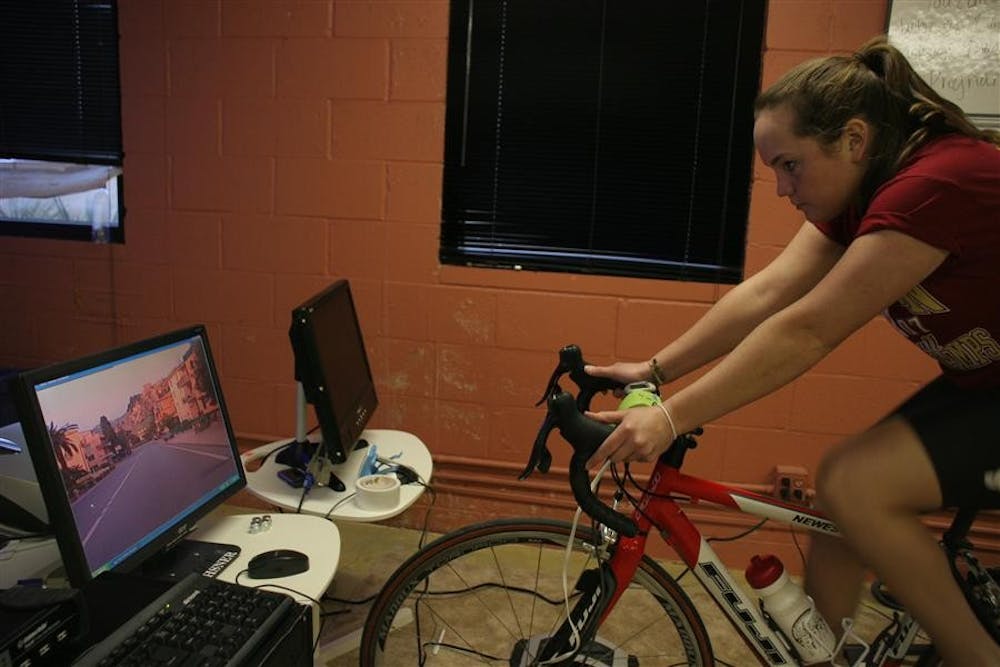Wing It riders Ali Bickel and Maria Srour pedal through Spain after class.
While some Little 500 riders spend their winter days riding stationary bikes at the Ora L. Wildermuth Center, the Wing It team works in front of what they refer to as an “anti-boredom machine.”
A training room with a rider’s best winter dream sits waiting to be hooked and wired into the Wing It bicycles. The dream is a training program by Tacx, which helps Wing It riders trek around the world without leaving their bicycles in Bloomington.
“When you’re stuck with weather like this, it kind of takes the edge off,” Wing It coach Tom Schwoegler said.
Srour and Bickel pedal as their bicycles are hooked up to a computer, using everything from the rear wheel’s speed to the course’s elevation data to provide an accurate ride for the Little 500 competitors.
“A guy by the name of Phil Stone got the cool job of videotaping all these courses,” Schwoegler said. “He goes out with a real nice high-def camera and gets to drive these great rides, and he takes elevation data every 100 meters, so the stuff is really, really accurate.”
Twenty-eight different rides from around the world include courses from city roads to Tour de France stages. Each ride lasts between 50 to 70 miles.
“Six years ago, I was at the Interbike show in Las Vegas, and this kid asks ‘Do you mind if I ride this?’” Schwoegler said. “I said ‘Go ahead. Jump on it.’”
The teenager rode the Mt. Ventoux course, one of the most grueling stages of the Tour de France.
A few minutes later, the teenager stopped pedaling.
“The kid said, ‘This is scary. I was on Ventoux two weeks ago, and my legs are telling me that I’m back on Ventoux,’” Schwoelger said.
When a course has an incline, the computer signals the trainer to increase tension in the rear wheel, creating the feeling of resistance. If Wing It’s coach ever feels like his riders need a new ride other than one of the 28 offered, Schwoegler can use Google Maps to design his own ride for his team through the Tacx software.
“The world really is your training course,” Schwoegler said.
The downside of the training center, Bickel said, is that ultimately, the team would rather be training outdoors. However, it provides an alternative to the HPER, where bikes might not always be available.
Srour agreed that riding in the open air is better.
“Sometimes the software doesn’t work, and you’re still on a trainer,” she said. “It is sort of an anti-boredom thing. It breaks it up because getting on a trainer is really boring because it’s the same thing ... I don’t think I’m any more efficient than someone riding on a spin bike in the HPER, but it gives me more motivation to do my rides.”
Schwoegler is not yet sure if the equipment is helping his team’s performance or endurance. But for him, the true result that matters is the one on race day.
“I think any person who is on their bike, they’re going to see some kind of improvement,” Schwoegler said. “If you can improve that experience, you’re going to want to continue. For me, even if this gives them a little edge so they’re not as bored ... then we’re that much farther ahead.”
Wing It riders train for Little 500 on hi-tech bicycle

Get stories like this in your inbox
Subscribe




